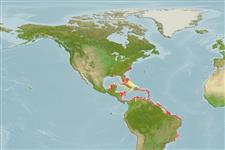Preferred temperature (Ref.
123201): 23.1 - 28.1, mean 27.1 °C (based on 760 cells).
Phylogenetic diversity index (Ref.
82804): PD
50 = 0.5039 [Uniqueness, from 0.5 = low to 2.0 = high].
Bayesian length-weight: a=0.00646 (0.00265 - 0.01571), b=3.06 (2.86 - 3.26), in cm total length, based on LWR estimates for this (Sub)family-body shape (Ref.
93245).
Nivel trófico (Ref.
69278): 3.7 ±0.2 se; based on diet studies.
Resiliencia (Ref.
120179): Bajo, población duplicada en un tiempo mínimo de 4.5-14 años (Assuming fecundity<100).
Fishing Vulnerability (Ref.
59153): Very high vulnerability (90 of 100).
Nutrients (Ref.
124155): Calcium = 26.4 [3.6, 122.6] mg/100g; Iron = 0.744 [0.197, 2.068] mg/100g; Protein = 23.9 [21.1, 26.5] %; Omega3 = 0.23 [0.06, 0.69] g/100g; Selenium = 12.5 [3.8, 37.8] μg/100g; VitaminA = 9.03 [3.46, 23.49] μg/100g; Zinc = 0.738 [0.357, 1.351] mg/100g (wet weight);
